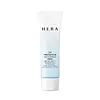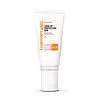What's inside
What's inside
 Key Ingredients
Key Ingredients

 Benefits
Benefits

 Concerns
Concerns

 Ingredients Side-by-side
Ingredients Side-by-side

Water
Skin ConditioningDibutyl Adipate
EmollientPropanediol
SolventEthylhexyl Triazone
UV AbsorberTerephthalylidene Dicamphor Sulfonic Acid
UV AbsorberArginine
MaskingNiacinamide
SmoothingPolyglyceryl-3 Distearate
Emulsifying1,2-Hexanediol
Skin ConditioningPentylene Glycol
Skin ConditioningCetearyl Alcohol
EmollientDiethylamino Hydroxybenzoyl Hexyl Benzoate
UV FilterPolysilicone-15
UV FilterGlycerin
HumectantCaprylyl Methicone
Skin ConditioningPolymethylsilsesquioxane
Glyceryl Stearate
EmollientBis-Ethylhexyloxyphenol Methoxyphenyl Triazine
Skin ConditioningPotassium Cetyl Phosphate
EmulsifyingMethylpropanediol
SolventSodium Acrylates Crosspolymer-2
AbsorbentInulin Lauryl Carbamate
Emulsion StabilisingCarbomer
Emulsion StabilisingParfum
MaskingAcrylates/C10-30 Alkyl Acrylate Crosspolymer
Emulsion StabilisingGlyceryl Stearate Citrate
EmollientSphingomonas Ferment Extract
Skin ConditioningEthylhexylglycerin
Skin ConditioningAdenosine
Skin ConditioningPolyether-1
Butylene Glycol
HumectantTocopheryl Acetate
AntioxidantEthylhexyl Palmitate
EmollientPaeonia Suffruticosa Extract
Skin ConditioningPaeonia Lactiflora Root Extract
Skin ConditioningBiosaccharide Gum-1
HumectantDisodium EDTA
Saccharomyces Ferment Filtrate
HumectantTocopherol
AntioxidantHelianthus Annuus Seed Oil
EmollientPaeonia Albiflora Flower Extract
TonicBeta-Carotene
Skin ConditioningDna
Skin ConditioningHamamelis Virginiana Bark/Leaf/Twig Extract
Skin ConditioningPelargonium Graveolens Extract
MaskingGardenia Florida Flower Extract
Skin ConditioningSalvia Officinalis Water
Skin ConditioningPanthenol
Skin Conditioning3-O-Ethyl Ascorbic Acid
Skin ConditioningWater, Dibutyl Adipate, Propanediol, Ethylhexyl Triazone, Terephthalylidene Dicamphor Sulfonic Acid, Arginine, Niacinamide, Polyglyceryl-3 Distearate, 1,2-Hexanediol, Pentylene Glycol, Cetearyl Alcohol, Diethylamino Hydroxybenzoyl Hexyl Benzoate, Polysilicone-15, Glycerin, Caprylyl Methicone, Polymethylsilsesquioxane, Glyceryl Stearate, Bis-Ethylhexyloxyphenol Methoxyphenyl Triazine, Potassium Cetyl Phosphate, Methylpropanediol, Sodium Acrylates Crosspolymer-2, Inulin Lauryl Carbamate, Carbomer, Parfum, Acrylates/C10-30 Alkyl Acrylate Crosspolymer, Glyceryl Stearate Citrate, Sphingomonas Ferment Extract, Ethylhexylglycerin, Adenosine, Polyether-1, Butylene Glycol, Tocopheryl Acetate, Ethylhexyl Palmitate, Paeonia Suffruticosa Extract, Paeonia Lactiflora Root Extract, Biosaccharide Gum-1, Disodium EDTA, Saccharomyces Ferment Filtrate, Tocopherol, Helianthus Annuus Seed Oil, Paeonia Albiflora Flower Extract, Beta-Carotene, Dna, Hamamelis Virginiana Bark/Leaf/Twig Extract, Pelargonium Graveolens Extract, Gardenia Florida Flower Extract, Salvia Officinalis Water, Panthenol, 3-O-Ethyl Ascorbic Acid
Water
Skin ConditioningCyclopentasiloxane
EmollientEthylhexyl Methoxycinnamate
UV AbsorberEthylhexyl Salicylate
UV AbsorberZinc Oxide
Cosmetic ColorantCyclohexasiloxane
EmollientButylene Glycol
HumectantPEG-10 Dimethicone
Skin ConditioningCI 77891
Cosmetic ColorantMethyl Methacrylate Crosspolymer
Dipropylene Glycol
HumectantEthylhexyl Palmitate
EmollientDimethicone/Vinyl Dimethicone Crosspolymer
Skin ConditioningPelargonium Graveolens Flower Oil
MaskingSea Water
HumectantCamellia Sinensis Leaf Extract
AntimicrobialPinus Pinaster Bark Extract
AntioxidantVitis Vinifera Seed Extract
AntimicrobialPortulaca Oleracea Extract
Skin ConditioningPearl Powder
Tourmaline
Caprylyl Methicone
Skin ConditioningCetyl PEG/PPG-10/1 Dimethicone
EmulsifyingDicaprylyl Carbonate
EmollientMagnesium Sulfate
Polymethylsilsesquioxane
Disteardimonium Hectorite
StabilisingIsoamyl P-Methoxycinnamate
UV AbsorberVinyl Dimethicone/Methicone Silsesquioxane Crosspolymer
C30-45 Alkyl Cetearyl Dimethicone Crosspolymer
EmollientAluminum Hydroxide
EmollientStearic Acid
CleansingGlyceryl Caprylate
EmollientDimethicone
EmollientCaprylyl Glycol
EmollientHydroxyapatite
AbrasivePanthenol
Skin ConditioningTriethoxycaprylylsilane
Montmorillonite
AbsorbentBiosaccharide Gum-4
Skin ConditioningThioctic Acid
AntioxidantUbiquinone
Antioxidant1,2-Hexanediol
Skin ConditioningPhenoxyethanol
PreservativeCitronellol
PerfumingGeraniol
PerfumingCitral
PerfumingCI 77492
Cosmetic ColorantCI 77491
Cosmetic ColorantWater, Cyclopentasiloxane, Ethylhexyl Methoxycinnamate, Ethylhexyl Salicylate, Zinc Oxide, Cyclohexasiloxane, Butylene Glycol, PEG-10 Dimethicone, CI 77891, Methyl Methacrylate Crosspolymer, Dipropylene Glycol, Ethylhexyl Palmitate, Dimethicone/Vinyl Dimethicone Crosspolymer, Pelargonium Graveolens Flower Oil, Sea Water, Camellia Sinensis Leaf Extract, Pinus Pinaster Bark Extract, Vitis Vinifera Seed Extract, Portulaca Oleracea Extract, Pearl Powder, Tourmaline, Caprylyl Methicone, Cetyl PEG/PPG-10/1 Dimethicone, Dicaprylyl Carbonate, Magnesium Sulfate, Polymethylsilsesquioxane, Disteardimonium Hectorite, Isoamyl P-Methoxycinnamate, Vinyl Dimethicone/Methicone Silsesquioxane Crosspolymer, C30-45 Alkyl Cetearyl Dimethicone Crosspolymer, Aluminum Hydroxide, Stearic Acid, Glyceryl Caprylate, Dimethicone, Caprylyl Glycol, Hydroxyapatite, Panthenol, Triethoxycaprylylsilane, Montmorillonite, Biosaccharide Gum-4, Thioctic Acid, Ubiquinone, 1,2-Hexanediol, Phenoxyethanol, Citronellol, Geraniol, Citral, CI 77492, CI 77491
 Reviews
Reviews

Ingredients Explained
These ingredients are found in both products.
Ingredients higher up in an ingredient list are typically present in a larger amount.
1,2-Hexanediol is a synthetic liquid and another multi-functional powerhouse.
It is a:
- Humectant, drawing moisture into the skin
- Emollient, helping to soften skin
- Solvent, dispersing and stabilizing formulas
- Preservative booster, enhancing the antimicrobial activity of other preservatives
Butylene Glycol (or BG) is used within cosmetic products for a few different reasons:
Overall, Butylene Glycol is a safe and well-rounded ingredient that works well with other ingredients.
Though this ingredient works well with most skin types, some people with sensitive skin may experience a reaction such as allergic rashes, closed comedones, or itchiness.
Learn more about Butylene GlycolCaprylyl Methicone is a type of silicone.
It helps soften and soothe the skin by creating a thin film on top. This film helps trap moisture, keeping your skin hydrated.
Ethylhexyl Palmitate, also known as octyl palmitate, is created from 2-ethylhexyl alcohol and palmitic acid. It is a fatty acid ester.
The fatty acid content of Ethylhexyl Palmitate makes it an emollient. Emollients help soften and hydrate your skin by trapping moisture within.
Ethylhexyl Palmitate is also used to help improve the texture of cosmetics. It helps other ingredient dissolve in products and help disperse ingredients more evenly.
You'll likely find this ingredient in sunscreen, as it is often used to mix UV-blocking ingredients such as avobenzone and ethylhexyl triazone.
It can also help stabilize the fragrances in a product as a fragrance fixative.
Ethylhexyl Palmitate can be used to substitute mineral oil.
Due to its high fatty acid content, it may not be fungal-acne safe.
Learn more about Ethylhexyl PalmitatePanthenol is a common ingredient that helps hydrate and soothe the skin. It is found naturally in our skin and hair.
There are two forms of panthenol: D and L.
D-panthenol is also known as dexpanthenol. Most cosmetics use dexpanthenol or a mixture of D and L-panthenol.
Panthenol is famous due to its ability to go deeper into the skin's layers. Using this ingredient has numerous pros (and no cons):
Like hyaluronic acid, panthenol is a humectant. Humectants are able to bind and hold large amounts of water to keep skin hydrated.
This ingredient works well for wound healing. It works by increasing tissue in the wound and helps close open wounds.
Once oxidized, panthenol converts to pantothenic acid. Panthothenic acid is found in all living cells.
This ingredient is also referred to as pro-vitamin B5.
Learn more about PanthenolPolymethylsilsesquioxane is a silicone used as a film forming agent.
When applied to the skin, this ingredient creates an invisible film on the surface. This film still allows oxygen to pass through, but prevents moisture from escaping. This can help condition and hydrate the skin. It also leaves a silky feel when applied.
Polymethylsilsesquioxane has not been shown to clog pores. It has been deemed safe to use up to 55%, but most cosmetics use much less.
If you have concerns about using this ingredient, we recommend speaking with a professional.
Learn more about PolymethylsilsesquioxaneWater. It's the most common cosmetic ingredient of all. You'll usually see it at the top of ingredient lists, meaning that it makes up the largest part of the product.
So why is it so popular? Water most often acts as a solvent - this means that it helps dissolve other ingredients into the formulation.
You'll also recognize water as that liquid we all need to stay alive. If you see this, drink a glass of water. Stay hydrated!
Learn more about Water